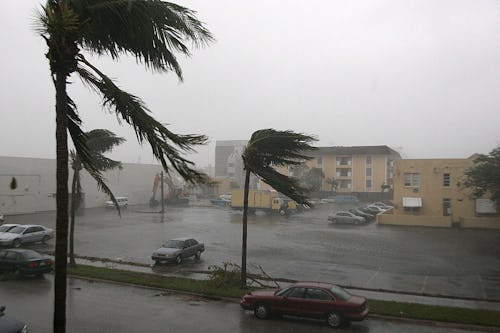
Here’s a sign of where we’re at with the whole climate change thing: Scientists are calling for a new categorization in order to accurately describe just how powerful and destructive hurricanes are becoming. According to a report from USA Today, scientists are playing around with the possibility of introducing a new level to the Saffir-Simpson Hurricane Wind Scale, which is the system we currently use to rate hurricanes on a scale of one through five.
But now, scientists are toying with adding a Category Six, which would be reserved for so-called super hurricanes that have wind speeds that exceed the highest level of the current scale, which is Category Five.
This is an idea that has been in floating around for a while now. It most recently gained steam after Hurricane Dorian hit the Bahamas in 2019, which brought with it winds that reached speeds of 185 miles per hour and produced sustained storm conditions that pounded islands in the Atlantic for 24 hours straight. Dorian ultimately did more than $3.4 billion in damage and killed at least 74 people.
Under the existing hurricane scale, Dorian was a Category Five storm: wind speeds of 157 mph or higher, and risk of catastrophic damage that can destroy buildings and flood streets. But Category Five serves as a sort of catch-all for all powerful storms, and it doesn’t fully capture just how bad things can get. The Saffir-Simpson Scale increases the storm rating every 15 mph, and Dorian produced winds much more than 15 mph faster than Category Five captures. If the scale extended to a Category Six rating, Dorian would have qualified.
Dorian won’t be the last storm to push the limits of the Category Five label, either. As the planet warms, the result of human-caused climate change, it creates the conditions that hurricanes thrive in: warmer water and wetter air. The result, researchers have found, is more hurricanes that would otherwise be less powerful or fizzle out instead reaching strengths of Category Three or higher.
Researchers are already starting to explore just how bad things could get. Earlier this year, the U.S. National Science Foundation awarded a grant to Florida International University to build a Category Six hurricane simulator capable of showing what kind of damage would be caused by winds of up to 200 mph. The reality is, scientists are looking into this because it’s likely to happen. There have already been several hurricanes in other parts of the world that would have risen to the level of a Category Six storm if the term formally existed. They’ll find their way to U.S. shores at some point, too. We can either acknowledge that, prepare for it, and properly label them, or we can keep pretending like the worst-case scenario isn’t progressively getting even worse.







